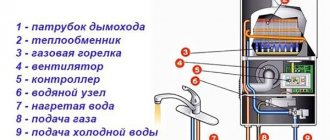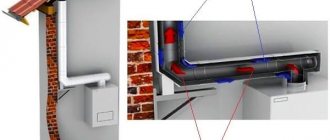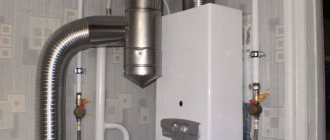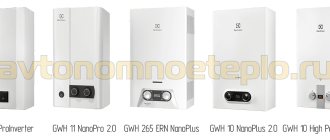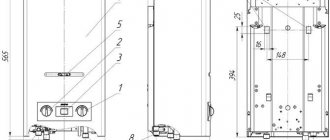Using geysers is one of the most popular methods for heating water in the house. And this is not surprising, because the column is capable of supplying hot water at any time and in the quantity that its owner requires. Equipment manufacturers note the popularity of gas water heaters among the population: previously released models are modified and improved, new technologies appear, and all together this results in an influx of many new types and models of gas water heaters onto the market. How not to get lost in such a variety of models and types, and how to choose a gas water heater?
- 1 Main types and types of gas water heaters 1.1 Classification of water heaters according to the type of ignition in them
- 1.2 Classification of columns according to the type of burners installed in them
How to repair the ignition unit on a gas water heater

Flow-through gas boilers, depending on the model, are ignited manually, semi-automatically and fully automatically. Combustion control is carried out by several sensors and structural units.
The geyser ignition unit, when in working condition, prevents emergency situations from occurring, ensures that the main burner is activated when the hot water tap is opened and the flame extinguishes after it is closed. There are several types of columns, classified by type of ignition, differing in internal structure and operating principle.
Review of the best manufacturers of gas water heating devices
In order for the long-awaited purchase to work for more than one year, you need to choose a water heating device from the most popular companies that offer geysers.
Ariston – Italian quality at reasonable prices. The speakers of this company are equipped with various additional functions: support for a given temperature, LCD display, 3 combustion power modes. Components and components are made from high-quality composite materials, which guarantee long service life and resistance of components to corrosion. Intelligent microcomputer control maintains the water temperature at a constant level. The line of equipment of this company combines high technology, European quality and many years of experience of the company. Thanks to its small size, the compact design saves space in the room and is suitable for any interior.
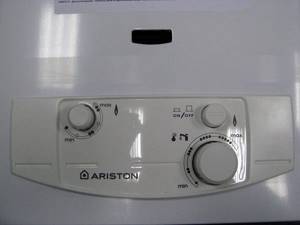
Geyser Ariston
Vaillant is a high-quality German manufacturer on the Russian gas equipment market. Gas water heaters from this company have a power of 10 to 30 kW. The devices are characterized by high performance and ease of use. The main advantages of this brand include: simple control using a convenient LCD display, original design and quiet operation. The equipment is equipped with a reliable copper heat exchanger.
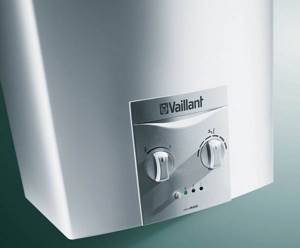
Geyser Vaillant
Junkers is a line of speakers that are manufactured in Germany by Bosch. Water heating devices are adapted for Russian operating conditions. A distinctive feature is the presence of flame modulation, due to which the power automatically changes depending on the supplied water. They do not heat up from the outside, have a protective coating and operate silently. The devices are characterized by high operating efficiency.
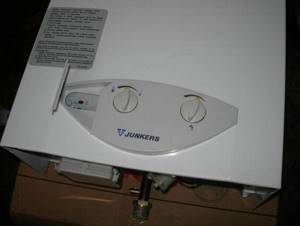
Geyser Junkers
Electrolux - decent quality Swedish equipment at the best price. Gas water heaters from this company have a power from 17 to 31 kW. The burner is made of stainless steel, and the heat exchanger is made of copper, which guarantees a long service life of such equipment. The geyser has a hydraulic type safety valve, which serves to protect the unit from overheating. Since geysers are equipped with a small number of nozzles, the equipment operates silently. Some models (for example, Electrolux GWH 265) are equipped with automatic flame adjustment to keep the coolant temperature constant even if the water pressure decreases. For operational safety, an innovative Intelligent control system is used, which monitors the functioning of all sensors and systems.

Geyser Electrolux
Termaxi are inexpensive Chinese-made geysers that are in demand among consumers. They have modulating burners, which is a competitive advantage compared to other brands. The line of water heating devices includes a model capable of producing 12 liters of hot water per minute. Up to three water intake points can be connected to such equipment.

Geyser Termaxi
Beretta are Italian water heaters of excellent quality. The advantages of the models from this company: ease of use, thoughtful design, high build quality, huge range. The company's product line includes two types of water heaters: with flame modulation and with electric ignition.
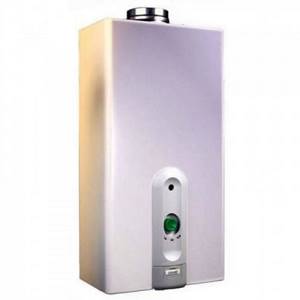
Geyser Beretta
Speakers with manual ignition - from matches
Old style geysers are lit with matches. A constantly burning pilot light is used for ignition. Light the wick with a match. The column is turned on as follows:
- Ignition of the igniter - the wick device includes an electromechanical valve. When heated, enough energy is created to close the contacts and provide gas supply. During manual ignition, press the valve button and light the igniter. After 1-2 minutes, release the key. The wick continues to burn. The operating principle of the pilot burner requires constant maintenance of the flame. The wick is usually lit in the morning and extinguished in the evening.
- Turning on the main burner - when the DHW tap is opened, the ignition signal is transmitted through the frog (water reducer) of the boiler. Inside the unit there is a rod that opens the gas supply.
Gas water heaters with piezo ignition
The main difference between piezo ignition and flow-through boilers with manual ignition is that the pilot burner is ignited by means of a piezo element built into the design. Despite the popularity of automatic water heaters, domestic and foreign manufacturers still produce gas instantaneous water heaters with piezo ignition and a constantly running pilot burner.
The principle of operation is in many ways similar to that used in columns, where the burner is ignited by matches. There are common structural elements, but the same breakdowns occur.
Piezo ignition device
The design includes a constantly working ignition wick. To turn on the column you need to light the igniter. For ignition, the design contains a piezoelectric element, consisting of a power button connected to a spark electrode connected to the burner device. When the key is pressed, a spark is produced, hitting the burner, igniting the gas.
The operating principle of a piezoelectric element is associated with the conversion of mechanical and kinetic energy into electrical energy. When pressed, a spark is generated that is strong enough to ignite the burner. Piezo ignition for a gas water heater often fails. After 3-4 years, the unit will need to be replaced and adjusted.
How to replace a piezo element
Signs of a malfunction: weak spark, ignition after a large number of presses on the element key (in normal condition it fires with 1-2 clicks).
First you should try to repair the piezo ignition. It happens that a fault is caused by breakdowns in the current-transmitting cable. To see the cause of the problem, disconnect the speaker housing. After this, press the piezo ignition button several times and watch where the spark is directed.
There is a spring in the supply pipe of the ignition burner for cutting the gas. An additional function is to receive a spark from the piezo. The spring should be bent towards the electrode.
If the changes do not help, there is no spark, if the location of the electrodes is changed, the situation does not change, the piezoelectric element of the gas column should be replaced. The key can be easily removed. Depending on the model, the housing is secured with a lock nut or several bolts. The wire from the electrode is removed by removing the terminal. If you have certain skills, the work takes 10-15 minutes.
What is cheaper: gas or electric water heater?
- Connection - an electric water heater differs from a gas water heater in that a project is not needed for its installation. A storage or flow-through electric boiler is as safe as possible. Electric water heating equipment can be installed in any room, regardless of the purpose and size of the room.
Installation work on a storage electric boiler Tank volume (l) Installation cost (RUB) 10-15 2500 30 3000 50 3500 80-100 4000 from 100 4500 Installation work for a flow-through electric boiler Power, kWt) Installation cost (RUB) until 3 1500 from 3.1 to 5.5 1800 from 5.6 2300 Gas equipment must be registered. If the highway is not connected to the house, then the project and installation work can cost up to 300,000 rubles. Estimated cost of installation work in the apartment:
Services list Cost from (RUB) 1 Call a specialist 300 3 Installation of a geyser 2500 4 Setting up and starting a gas boiler 2200 5 Installation of a combustion products exhaust system (for one segment, including material) 800 6 Installation of a smoke exhaust system for reinforced concrete (for each element, together with the material) 500 8 Tying the geyser with polypropylene or metal-plastic pipes 400 9 Installation of shut-off valves on a gas pipe 500 10 Removing an old gas boiler 400 - Maintenance - the storage tank and column must be inspected every year, performing minor repairs. The magnesium anode in an electric water heater needs to be changed, and the heat exchanger in gas equipment must be cleaned of scale. Service costs vary. The price is largely influenced by the distance of the official representative office of the manufacturer from the place of residence of the owner of the water heating equipment, as well as the territorial affiliation of the brand of the water heater. German equipment will be more expensive to repair than Korean or Italian equipment.
Electric ignition for a gas water heater
Present in fully automatic boilers. The operating principle of an instantaneous gas water heater with electric ignition eliminates the need for a constantly burning wick. The main burner ignites immediately. The source of electricity is a 220 W household network, batteries or a hydrogenerator built inside.
Automatic electronic ignition of the gas water heater occurs when the hot water tap is opened. After closing the DHW point, the burner goes out on its own.
Battery ignition
The electronic ignition unit for geysers is used in fully automatic water heaters. In the factory configuration, batteries are used as batteries.
Electronic ignition of a gas water heater works as follows:
the rod in the water reducer has special legs connected to the electric ignition;
when the hot water supply is turned on, the membrane presses on the rod, opens the gas valve and at the same time gives a signal to generate a spark;
Battery power has one significant drawback. Replacement of elements is required every six months. If desired, you can install an adapter and connect the speaker to a household electrical outlet through it. This solution will eliminate the need for constant and frequent replacement of batteries.
Ignition from a hydrogenerator
In the new generation of speakers, the batteries were replaced with a turbine. Gas water heaters with a hydrogenerator are turned on by producing electric current through the conversion of mechanical energy.
The water heater operates in completely autonomous mode, but has several disadvantages:
- sensitivity to pressure and water quality;
A spark from a hydrodynamic generator is produced only when the water pressure is sufficiently high. At a pressure of 0.3-0.5 atm. The automatic battery-powered water heater turns on normally, but the water heater with a turbine simply won’t start. To ensure stable operation of a device with hydrodynamic ignition, it is necessary to use a booster pump and a water treatment system, including several degrees of purification.
Selecting a gas water heater based on technical parameters
The main technical indicator of a geyser is power. It indicates the volume of water heated per minute. High power is justified if there are several connection points for the water heater and at least several consumers.
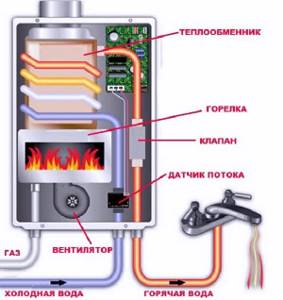
The principle of operation of the gas water heater
If one person lives in the house, it is more logical to purchase a low-power speaker. However, if you plan to let someone else into your home, you can look ahead in purchasing a water heater. In terms of power it can be:
- Low-power with an output of 18-19 kilowatts.
- Medium-power with an indicator of 22-24 kilowatts
- High-power with an indicator from 28 to 31 kilowatts.
The need for a powerful device may be hindered by low water pressure in the system. How to heat the maximum volume of liquid in a minute if it does not flow? An additional pump can be installed. However, this will reduce the pressure in neighboring apartments even further.

Geyser Oasis with electric ignition
Problems with water pressure, by the way, are typical for buildings connected to worn-out Soviet-style networks with small pipe diameters or for apartments on high-rise floors. In order for water to reach them, the pressure required is many times greater than to supply the first floors.
What is a column flame ionization sensor
There are several systems inside instantaneous water heaters that block the gas supply if normal operating conditions are violated. The gas column ionization sensor monitors the presence of a flame. When it fades, a signal is sent to block the gas supply. In modern instantaneous boilers, the role of the regulator is performed by:
The principle of operation is based on the fact that during the combustion process in gas columns, flame ionization or the production of ion current is created. The amount of energy is directly proportional to the intensity of combustion. Incorrect gas-air mixture ratio, dust settling, and extinguishing of the main burner lead to the sensor triggering. By blocking the gas supply, gas leakage is prevented when the burner goes out spontaneously.
How to light a column correctly
Ignition is carried out as follows:
- the gas supply button is pressed;
after 10-15 seconds, the piezoelectric element key is pressed or a burning match is brought up (depending on the type of ignition);
A geyser with electric ignition turns on independently when the hot water tap is opened. Switching on should be silent. Popping noises and prolonged operation of the spark generator unit indicate a malfunction.
Which is better - piezo ignition or electric ignition for a speaker?
When deciding which dispenser is better, an automatic or a semi-automatic, several important operating points and operational characteristics are taken into account, as well as possible malfunctions that the owner of the equipment will have to face:
- Piezo ignition - the column works almost without failure. During the initial stages of operation, it may be necessary to adjust the wick flame. Over time, after 4-5 years of use, the igniter will need to be adjusted. As obvious disadvantages, the need for a constantly working wick, which significantly increases gas consumption.
As statistics show, the choice between piezo ignition or electric ignition for domestic consumers is often made in favor of the latter. In Europe, preferences are not so obvious. Both types of instantaneous gas boilers are in demand. Ease of use and economical consumption of blue fuel are the main reasons for purchasing a dispenser with automatic switching on.
Source
Optimal power performance
According to the practical experience of specialists, various models of geysers work at one point in a residential area. Therefore, for their correct functioning, a supply of 19-24 kW is sufficient (the exception is the presence of more than one bathroom in an apartment or house). If it is necessary to select a more powerful device, the consumer should take into account the functional features and capabilities of the water supply system used in the residential property. The analysis should concern the determination of the possibility of providing the appropriate level of resource supply under pressure to operate three water release points at once.
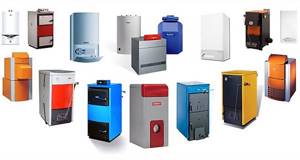
Modern models of geysers allow you to adjust the level of your own power in the following intensity modes:
- smooth. The design of the device provides the user with the ability to regulate the power of the device by turning a special lever from the minimum to the maximum value;
- stepped. Provides the user with the ability to choose between low, medium and highest hot water temperatures;
- auto. The mode allows you to regulate the temperature of hot water, according to the requirements relevant for a specific period of time and user. This type of device relieves the consumer of the possible risk of sudden changes in water temperature.
It is the level of power indicators that affects the time it takes for the device to heat a particular volume of water.
Description of the unit
The internal structure of instantaneous gas water heaters is the same and hardly differs from one manufacturer to another. The main difference may be in additional options (display, automatic gas ignition, second temperature sensor, etc.), in the appearance of the device or in the design.
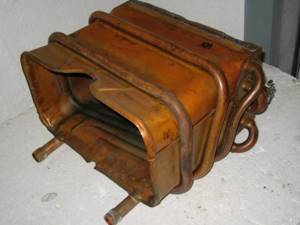
This is a geyser heat exchanger; it may look different from different manufacturers, but its operating principle is the same.
A heat exchanger is installed inside - a finned copper tube through which the water flow moves. The burner located under the heat exchanger heats the tube and the water passing inside it heats up. When the water pressure is low or absent, the incoming flow is blocked by a valve (curtain), to which a spark ignition switch is attached. This is done for fire safety.
No. 6. Column heat exchanger type
The durability and wear resistance of the column is directly related to the material used to make the heat exchanger:
- steel heat exchanger It is inexpensive, weighs decently, and is relatively reliable in operation. It is better to choose a model where the heat exchanger is made of stainless steel;
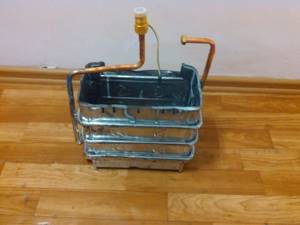
- highly purified copper resembles steel in its basic properties, but has higher heat transfer, so it will be possible to extract the maximum benefit from each cubic meter of gas;
- ordinary copper heats up unevenly, due to impurities. That is why many manufacturers cover the heat exchanger with heat-resistant paint, but it can only hold back destructive processes in the heat exchanger for a while.
It turns out that stainless steel and purified copper are the preferred options.
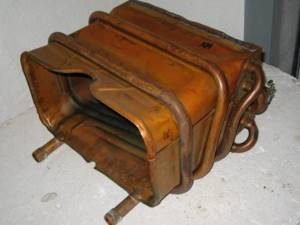
Call a professional or repair it yourself
We call the master
To repair a faulty geyser or prevent a gas leak (if you smell it), you need to call a geyser repair specialist. But if you decide to call Gorgaz workers, then do not think that they will come right away; sometimes they refuse to come, citing the fact that the repairs should be carried out by the company (or store) that installed the gas water heater.
Nowadays, many “leftist” companies have divorced , and calling the employees of such organizations to their homes brings a number of other problems. Many craftsmen, seeing your incompetence in this area, find non-existent malfunctions of the gas water heater or deliberately inflate prices.
DIY geyser repair
To increase the safety of the population, it is prescribed that malfunctions associated with gas equipment be eliminated by employees of the relevant service. But there are problems that you can fix yourself. If you know how to hold a tool in your hands, you can repair a geyser with your own hands.
This is not very difficult if you know the typical problems of these water heaters. Below we will talk about the most common of them and tell you how to fix this or that breakdown. Let's start by setting up the unit.
How to install
Before installing the Ariston column, you should decide on the height at which it will be fixed. This is necessary for safety, especially if there are young children in the family. Fastenings must be highly reliable. Using a drill, holes are made in the wall, after which the water heater is screwed in with self-tapping screws.
To connect to gas and water, tees are used, which are cut into pipes. Therefore, welding will definitely be required.
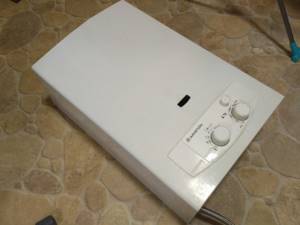
After the work is completed, you should learn how to turn on the Ariston column. Each boiler has its own instructions for use, in which everything is indicated step by step.
Important! However, it is worth keeping in mind that the initial installation and connection must be carried out by a specialist. Each model has its own characteristics, and this can be very important.
Adjusting the geyser
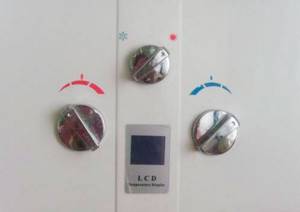
Adjusting the burner flame height - the closer to the maximum, the hotter the water. Adjusting the water flow - the closer to the maximum, the greater the flow, therefore, the colder the water. Winter/Summer - mode of using the speaker at different times of the year. In winter the power is greater than in summer.
Not all craftsmen know how to properly set up a gas water heater and simply do not do it, leaving it as it is (by default). But we do not recommend leaving the settings at the factory settings and making adjustments yourself.
WATER AND GAS PRESSURE
For each column, the data sheet specifies two main water pressure parameters: the minimum at which the unit will turn on, and the maximum - the pressure that the heat exchanger can withstand without losing its integrity. It is advisable to clarify all the parameters of your water supply network before choosing a gas water heater.
For city apartments where water heaters are used (and these are mostly Khrushchev and Stalin buildings, i.e. old housing stock with worn-out communications), it is better to choose a unit that can operate with minimal water pressure . Therefore, pay attention to those devices that can heat water at a pressure of as low as 0.15 bar.

Geyser - water pressure
High pressure can be destructive to the column, and water hammer, alas, is not uncommon. Buy units that can withstand a short-term increase in network pressure up to 11-12 bar.
Also, do not forget to check what gas pressure the dispenser can operate with. In domestic gas pipelines, the gas pressure is lower than in European ones (13 mbar versus 20 mbar), so when buying a dispenser from a European manufacturer, you need to inquire for which market it was produced, and whether it has a gas reducer installed in order to maintain constant pressure.
The heat exchanger is clogged with scale
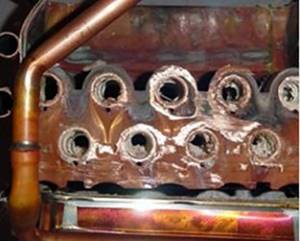
With our water quality, heat exchangers in geysers become clogged with scale quite quickly and very heavily, which reduces their thermal conductivity and increases gas consumption.
The longest process in terms of time is cleaning the main tube (radiator) from deposits that arise when heating tap water. If you turn the gas knob all the way, and the water coming out is barely warm, then this indicates that the heat exchanger is clogged with ordinary scale, which does not transfer heat well.
This happens quite often if the gas water heater does not have automatic ignition (with a igniter). Scale also forms if you set the water heating temperature too high. The unit overheats, the tube (radiator) heats up to 80-850, which contributes to the rapid (a little more than an hour) formation of scale. Isn't it better to just turn off the speaker in time? Then there will be no problems, because 40-600 is enough for all washing and washing processes.
Before starting work on the heat exchanger, check the inlet tap or valve. Maybe the whole reason is that they are clogged. But if they are working properly, it is necessary to get rid of deposits in the tube.
There are two ways to solve the scale issue. We will consider both options.
Auto
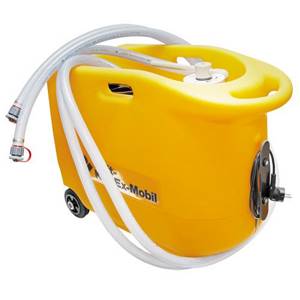
The Cillit KalkEx cleaning system does its job quite well. With its help you can quickly descale any boilers. Unfortunately, it is not very accessible to ordinary users of geysers.
This is an expensive method using a special device (Cillit KalkEx) and a set of special preparations for washing. Your speaker doesn't even need to be removed from the wall. You just need to disconnect the water hoses (inlet/outlet).
The purification device is connected to the column, and it circulates the heated reagents in a closed cycle (in a circle). The scale decomposes under their influence, is washed out and drained.
Manual
Cheap, but long and labor-intensive process . To do this, it is necessary to disassemble the water heater almost completely and then wash it manually.
The following materials and tools will help us with this:
- open-end wrenches (set);
- screwdrivers (phillips and regular);
- paronite gaskets (set);
- rubber hose;
- vinegar essence or anti-scale agent.
Disassembling the gas apparatus
To remove the heat exchanger, proceed in the following order:
- First, we block the access to cold water;
- then we remove external elements that prevent disassembly (switch handles, regulators);
- remove the casing, and to do this, unscrew the screws located on the rear wall of the unit, lift and remove the cover;
- open the “hot” tap;
- unscrew the supply tube from the heat exchanger and move it aside;
Flushing the system
After the water has completely drained, we put the hose on the heat exchanger tube and raise it above the level of the column. Slowly pour the solution we prepared into the hose and leave the column for 4-6 hours.
Next, you need to open the water supply tap a little and watch the water that will come out of the column; if you see a lot of scale, then our work was not in vain - we got rid of it . If there is no scale in the outlet water, then we repeat the whole process again.
How to choose and what to pay attention to 10 tips from a professional
When choosing a column, you need to pay attention to the number of water intake points that the device will serve, and the volume of hot water, which is calculated based on the needs of the family. There are other parameters that you should also take time to study
Volume of the tank
The main disadvantage of a boiler is the limitation in the amount of water. When the tank is empty, you need to wait half an hour or more for the required amount of water to heat up.
To reduce this minus to a minimum, you need to calculate the required tank volume. It is necessary to take into account the volume for washing and other needs.
NOTE! It is worth noting that too large a boiler can lead to unnecessary costs, so you should not ignore this point.
You can determine your needs using the information in the table.
| Needs | Volume of water in liters | Water supply liter/minute | Temperature C |
| Taking a bath | 120 | 15 | 42 |
| Shower | 35 | 6,5 | 42 |
| Hand washing | 4 | 7 | 42 |
| Washing dishes | 30 | 8 | 55 |
| Washing | 9 | 7 | 42 |
| Shaving | 9 | 7 | 55 |
The table contains data for providing hot water to one person in an apartment or private house. With simple calculations it is easy to find out how much water is required for several people. A boiler with a capacity of 80 liters is enough for two people, and 100 liters for three people.
To ensure a complete hot water supply in a house with several bathrooms, it is worth purchasing a heater with a volume of 180 liters or more to create comfortable living conditions for all family members.
The exact calculation is made using the formula: V = N x (t0 – t1) : (t2 – t1), where:
- V—boiler volume;
- N is the amount of water;
- t0—heating temperature;
- t1 - cold water;
- t2 is the intensity of hot water supply.

Geyser does not light up
- A water heater failure can occur for many reasons. We list the most likely of them:
- The simplest reason for this problem is the lack of normal draft in the chimney. If the chimney is clogged and there is no “draft” in it, then the column may not ignite.
- To check the malfunction, you can bring a piece of newspaper, a napkin or a lit match to the chimney. If they flutter, then the thrust is fine. Otherwise, you will need to clean the chimney.
- If the device (only in units with automatic ignition from batteries or the electrical network) does not ignite, then the battery is discharged or the wires or igniter unit are faulty. Eliminated by inserting batteries or checking the electric ignition system.
Failure of the igniter system to operate may occur due to poor water pressure. Open any cold water tap and check the pressure; if it is weak, you can call the housing office and find out what the problem is.
COMBUSTION CHAMBER TYPES
To choose a gas water heater, you need to pay attention to a lot of technical details, and the type of combustion chamber is one of the most important points. There are only two options here:
- open combustion chamber;
- closed combustion chamber.
Open chamber speakers are the simplest and cheapest. They use air from the room in which the device hangs to burn gas. The intake is carried out through the holes at the bottom of the column. Such units are installed in kitchens or in separate utility rooms (an excellent option for owners of private houses). Combustion products are removed through the chimney due to natural draft.
These types of devices are characterized by minimal noise during operation, but are more suitable for private homes, as they require connection to a chimney. In addition, the room where the device will be installed must be provided with adequate ventilation.
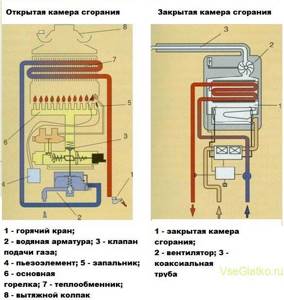
Geyser - combustion chamber
Columns with a closed combustion chamber receive air from the street. The chimney in such units is horizontal, goes out through the wall and is represented by a coaxial pipe (pipe in a pipe). Through the inner part of the pipe, combustion products are removed to the street using a fan, and air is supplied to the column through the outer pipe.
You can install such a unit in any room, it is safer, but you will have to pay more for such a speaker, and the operation of the fan depends on the availability of electricity and is accompanied by slight noise.
The geyser turns off spontaneously
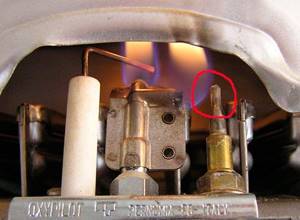
This is a temperature sensor that measures the temperature of the geyser during operation, preventing it from overheating.
A temperature sensor is installed on each gas water heater, which ensures that the water heater does not overheat; if it fails, the water heater may turn off spontaneously during operation . It usually looks like this:
After normal operation, for some time, the heater “stalls” for about 20 minutes. After this time, it can be turned on for the same period of time. The malfunction is usually seasonal and appears only in summer or winter when the windows are closed.
The device turns off when it wants and then does not light up . This can happen when the sensor wire is shorted to the body. Check the wires to ensure they are intact and well insulated.
In order to check the sensor itself for functionality, you should remove two contacts from it and short-circuit it with a needle, a paper clip, or a piece of tin. If the gas appliance turns on and works, the sensor must be changed.
COMBUSTION PRODUCTS DISCHARGE
We have already partially discussed this issue above, but now we will dwell in a little more detail. Depending on the type of carbon monoxide removal, there are:
- Classic, with chimney . Great for homes that already have a chimney. Otherwise, it will have to be built separately. For residents of apartment buildings, this option is in most cases impossible to implement;
- Chimneyless, or turbine . Combustion products are discharged through a pipe, a hole for which is made in the wall. Combustion products are drawn out due to the operation of the fan.
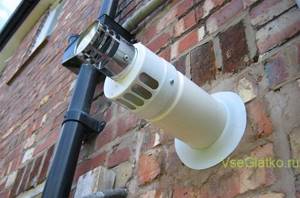
Geyser - chimney
The room in which the speaker is located must be well ventilated. If plastic windows were installed, you will have to equip them with a ventilation valve.
The water heater is leaking

If you see similar stains on your column, then be sure that it is leaking and needs repair.
This malfunction can occur mainly in geysers that have been operating for a long time. The two main reasons for the leak are:
The radiator is leaking.
Tubes (bends) or gaskets in connections are cracked. Replacing the radiator or taps is quite expensive. Therefore, there is a reason to repair the geyser on your own. For repairs you need:
- screwdrivers (cross and regular);
- open-end wrenches (set);
- solder with rosin;
- vacuum cleaner;
- solvent;
- "skin".
Sealing holes
Due to harsh operating conditions, the radiator or taps may burn out and holes may appear on them. If you have determined where the leak is, you can repair the small hole with a regular soldering iron.
Preparing a gas water heater for repair
- Drain all liquid from the system - open only the hot water tap, unscrew the nut on the cold water inlet pipe, and most of the water will flow out;
- Remove the radiator completely;
- Inspect the entire tube. - if you see “green”, clean and inspect these places for cracks.
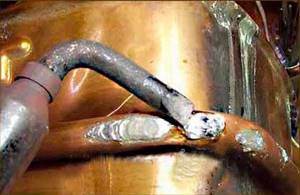
Soldering a heat exchanger does not always give good results; a lot depends on your skill. If the soldering is bad, the heat exchanger will quickly leak again.
When you have found leaks, you need to do the following:
- clean the holes found with sandpaper and immediately wipe with a cloth with solvent (this will remove any remaining grease, carbon deposits and dirt);
- using rosin with solder, tin this place with a 100-watt hoop (if you don’t have rosin, use aspirin);
- Fill the crack or hole with solder, and after it cools, add more tin (the layer should be 1-2 mm).
Faulty gaskets and tubes

Replacing flexible hoses of this type does not require special skills; anyone can do it with a wrench.
Very often, leaks form at the points where the taps are connected to the heater externally or to the internal components of the column. All connections are made “American” with gaskets inside.
Due to constant heating/cooling, rubberized liners either melt or lose their properties and harden. Cracks appear in them, through which water flows. If you notice a gas column leak in such connections, replace the gaskets. Using a wrench (usually 24), unscrew the nut and replace it.
It also happens that the flanges on the tubes crack over time - in this case, you need to replace the entire tubes.
Checking traction
Due to the fact that gas water heaters have an open combustion chamber, special attention is paid to draft to prevent carbon monoxide poisoning or create a dangerous emergency situation. To do this, it is important to correctly install the chimney and regularly check the presence and quality of draft.
Modern models of gas water heaters are equipped with sensors that, in the absence or low draft, simply will not allow the equipment to start. But in order to turn on an old gas water heater, you will probably have to make sure that there is draft, since such sensors have not yet been provided in it.
To correctly measure the presence of air flow, it is necessary to use special instruments. But you can do this without any special tools:
- At the point where the hood enters the ventilation shaft, it is necessary to remove a section of the exhaust pipe. The paper cut into strips is fixed in place of the hole. And based on their movement, the quality of traction is checked.
- A lit match is placed in the viewing window of the column. If the flame deviates, this indicates the presence of air flow.
If gas equipment is already working, but there is no draft, it is recommended to open the window for air flow.
The gas water heater turns on with a bang
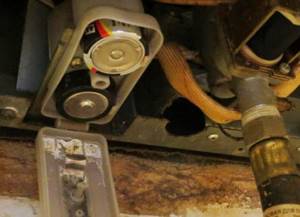
Be sure to change the batteries in the gas water heater on time, because if they are dead, your water heater will start making popping noises when turned on. Also, due to dead batteries, the speaker may turn off spontaneously.
These sounds when turned on and during operation indicate the following:
- due to the low gas pressure, some air got inside the system (into the burner), which caused a micro-explosion;
- the flame breaks out due to the high gas pressure;
- nozzle clogged;
- low ventilation draft;
- The batteries are low.
On your own, you can only fix the malfunctions described in the last two paragraphs.
